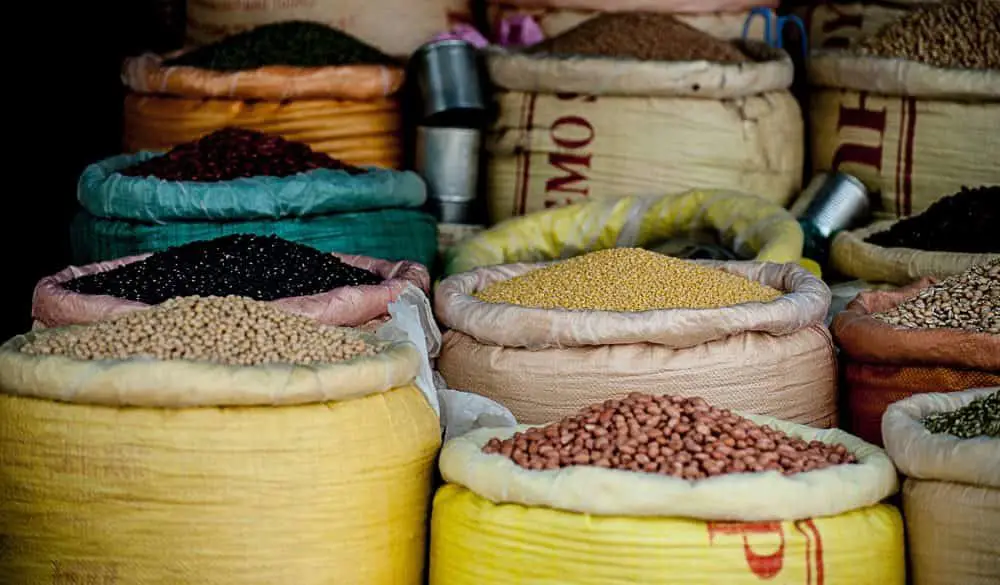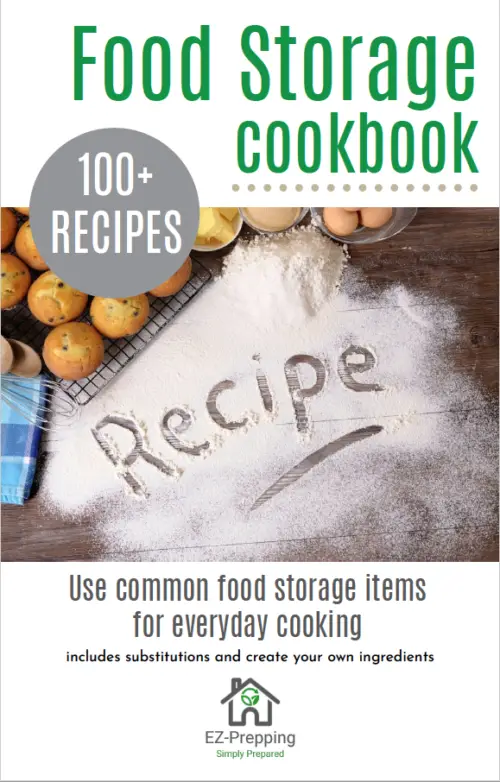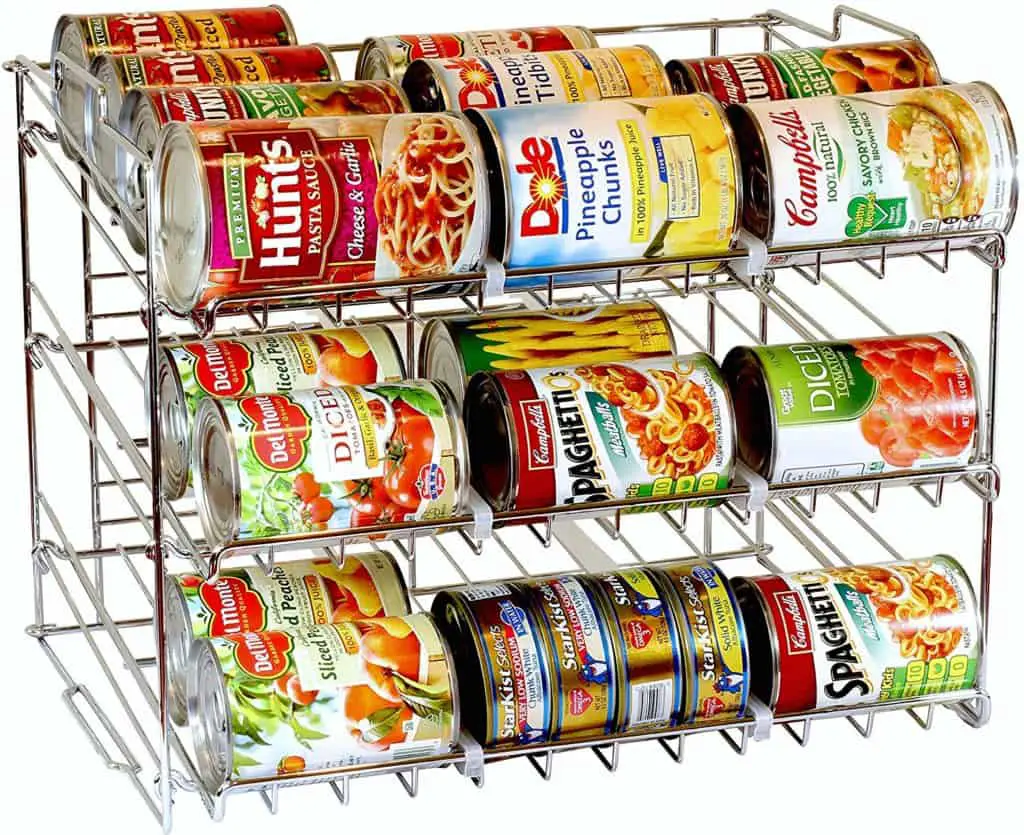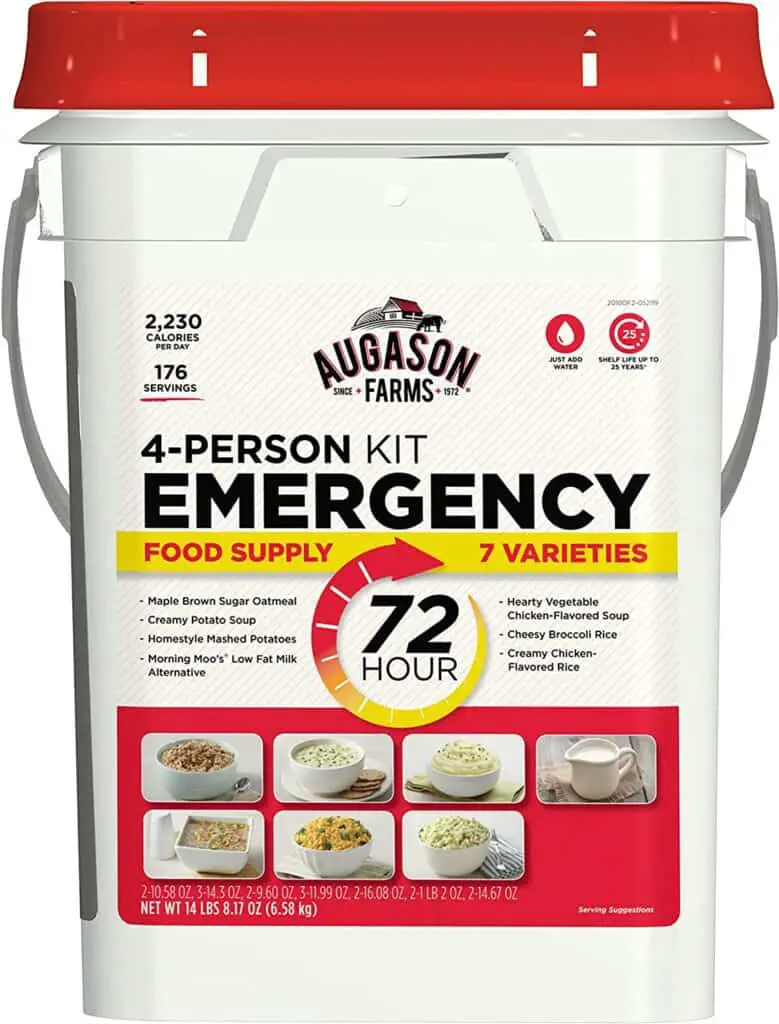Clicking on the link below to jump down the page right to our Food Storage Calculator!
Food Storage Calculator – Emergency Food Supply Calculator
Calculate 2 weeks, 1 month, 2 months, 3 months, 6 months, or 1-year food supply for your family with our food storage calculator! Use it to gain a good idea of the minimum food storage needed to feed everyone in your family. It includes recommended food storage of grains, canned or dried meats, fats and oils, beans, milk and dairy, sugars, fruits, vegetables, water, and other cooking essentials. The below calculator is based on estimates from organizations like the CDC and recommendations from the Church of Jesus Christ of Latter-Day Saints Home Production and Storage manual. These figures are minimum recommendations and may be increased to fit the needs of specific individuals and families. You will need to choose the best options and foods you should store for your family.
According to Healthline, the average woman needs to eat about 2,000 calories per day to maintain her weight. Meanwhile, the average man needs 2,500 calories to maintain his weight. Other factors to consider include age, height, current weight, activity levels, metabolic health, and others. The below calculator will provide enough calories to maintain most people’s weight. (Try my free survival calorie calculator)
How to Use Your Food Storage
Know exactly what to buy and how to use it in recipes that everyone in your family will enjoy so that nothing goes to waste. Plus long-term food storage substitutions and how to make your own ingredients! Check out the Food Storage Cookbook
Try Our Food Storage Calculator
We spent hours compiling lists of shelf-stable foods and our favorite food storage items so you don’t have to! We based these lists of food items on our food storage calculator. After using the below calculator check out these three lists/guides:
- Recommended food storage items: the best foods for long-term storage
- Foods that last a long time without a refrigerator
- List of all non-perishable foods that have the longest shelf-life
*Please give this calculator up to a minute to load.
*This food storage calculator rounds up to the nearest whole number.
I also spent hours compiling a list of my favorite freeze-dried foods/meals for long-term storage, camping, hiking, hunting, or any other circumstance! See my article Best Freeze Dried Foods: Must-Haves For Any Circumstance to find a few of the best freeze-dried foods to try out for yourself.
This food storage calculator is meant to be a quick and easy resource tool to help you calculate and plan for how much food storage you and your family will need over a period of time. The calculator has broken down food into its basic ingredients to give you an idea of the minimum amount that you will need to make basic meals for you and your family.
How to Expand Your Food Storage
When building your long-term food storage it is important to buy foods with a long shelf life (for example flour, rice, sugar, and freeze-dried foods) and learn to preserve your own foods using different methods because variety will enhance your food storage and provide you with more options in the chance of crisis or emergencies. Also, know what factors affect food storage life and how to prolong it.
What foods should you store?
- Wheat Berries
- Flour
- Rice
- Sugar
- Beef (6 Ways to Properly Store Beef)
- Freeze-dried food
- Foods Bought in Bulk
Expanding your food storage can be expensive so consider financially preparing yourself by finding the cheapest grocery stores, take advantage of deals by finding an Amish bulk food store near you or make it easier by finding the best places to buy bulk food online at a discount.
My Favorite food preservation methods include:
- Freeze Drying
- Canning (Pressure Canning “See what you can and cannot pressure can” and Water Bath Canning)
- Dehydrating (See best food dehydrators and what you can and cannot dehydrate)
- Freezing
- Vacuum Sealing food (Is a vacuum sealer worth it?)
- Also, store shelf-stable foods like wheat berries and find the best grain mill/flour grinder for you
It is critical to just get started and build up your short-term food storage first. This is your everyday food and meals that you eat on a regular basis that you can build up 1-3 months of a rotating pantry of foods and ingredients.
Don’t forget that it is just as important to have clean potable water so make sure you know how much water you need, how to store large amounts of water, and how to select the best emergency water filters.
Also, starting to buy food storage can be expensive so to help you plan and budget check out our simple prepping on a budget calculator and article.
Grow Your Food Storage to Prepare for Emergencies
Emergencies are often unexpected and unforeseeable so it is imperative to run through the most likely crisis or emergency situations that can happen in your area and come up with a plan on how to handle them.
A couple of things you’ll need to know and have:
- How to safely cook (even indoors) in an emergency without power
- 72-hour kits (go bags) for each family member and what should be included in them
- How to boil water without electricity
- How to prepare for and survive food shortages
- How to start prepping for beginners
Food Storage Containers
There are many great options out there for long-term and short-term food storage containers. We think it’s best to not get too hung up on what containers to get but to just order some so you don’t delay building up an emergency food supply that your family might desperately need. Check out this listing of long-term food storage containers on Amazon. There are many great options for containers that will work well for long-term food storage.
As for short-term food storage containers we enjoy the Rubbermaid Brilliance food storage containers that you can also find here on Amazon.
To learn more about safe plastic containers to us for food storage read our article Which Plastics are Safe for Food Storage and How to Use Them. Also, learn how to use oxygen absorbers and what dry foods to use them with.
How Much Food storage is needed Per Person? Per Year and Per Month
| Food Storage | Food Per Person Per Month | Food Per Person Per Year |
|---|---|---|
| Grains (Wheat, Rice, Flour, etc.) | 32.5 lbs | 390 lbs |
| Canned or Dried Meats (Freeze Dried, Beef, Jerky, Spam, fish, chicken, etc.) | 1.6 lbs | 20 lbs |
| Fats and Oils (Vegetable Oil, Peanut Butter, Shortening, etc.) | 2 lbs | 25 lbs |
| Beans (Dried Beans, Soy Beans, Split Peas, Dry Soup Mix, etc.) | 5.8 lbs | 70 lbs |
| Milk and Dairy (Powdered Milk, extra dairy) add about 2 cans of Evaporated Milk per month to the est. lbs | 7.25 lbs | 87 lbs |
| Sugars (Sugar, Brown Sugar, Honey, Powdered Drink Mixes, etc.) | 5 lbs | 60 lbs |
| Cooking Essentials (Salt, Baking Powder, Yeast, Vinegar, Jams, etc.) | .7 lbs | 8 lbs |
| Fruits & Vegetables (Dried) | 8 lbs | 90 lbs |
| Fruits & Vegetables (Canned) | 27 qts | 320 qts |
| Water Storage (Drinking Water Only) | 16 Gallons | 183 Gallons |
*This is an estimated monthly food storage for 1 person and is a minimum recommendation. For convenience, the results have been rounded to the nearest 10th. For greater customization to meet your specific needs see our Food Storage Calculator above!
Putting the Food Storage Calculator to Use
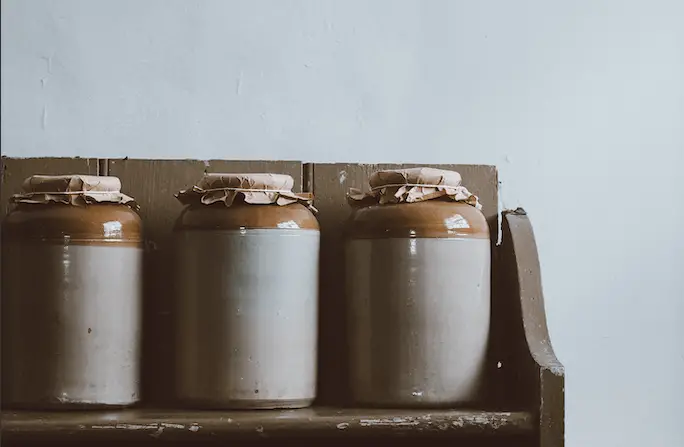
Track Your Meals Method to Enhance Our Food Storage Calculator
We love the track your meals method and encourage you to add it to our food storage calculator. It allows you and your family to track what you already eat and then breaking it down by ingredients and track it over the number of months you want to stock for. The best part about using this method is it can be made for your specific needs.
Here’s how it works: step by step to make it easy.
- Take your family’s favorite meal.
- Write out the recipe and times it by 12 (this will give you a year’s worth of that meal if you plan on eating it once a month.)
- Buy enough of the items to stock your pantry for a year of that meal.
- Do it again for the next meal.
Storing and Rotating Your Food Storage (FIFO)
It’s important to make sure that you are rotating your food storage using your older foods first so that nothing goes bad. First in first out (FIFO) method is helpful, especial for canned foods.
Canned Foods
Storing and rotating canned foods can be challenging. Applying the FIFO (first in first out) method can get disorganized when dealing with canned food. To help with this we have found having a good canned food organizer and rotator very useful even indispensable. We found one that is cheap and works well to rotate cans making FIFO easy. It is the DecoBros Stackable Can Rack Organizer (Click here to check the current price on Amazon). When we bought a couple of them they were only listed at about $20 each rack and it comes with adjustable plastic dividers making it able to accommodate various can sizes. It’ll store up to 36 cans depending on the can sizes being stored. This canned food organizer can help you put the above food storage calculator to use and build a working, rotating food storage and make organizing as easy as pie!
An Alternative to Powdered Milk for Short Term Storage
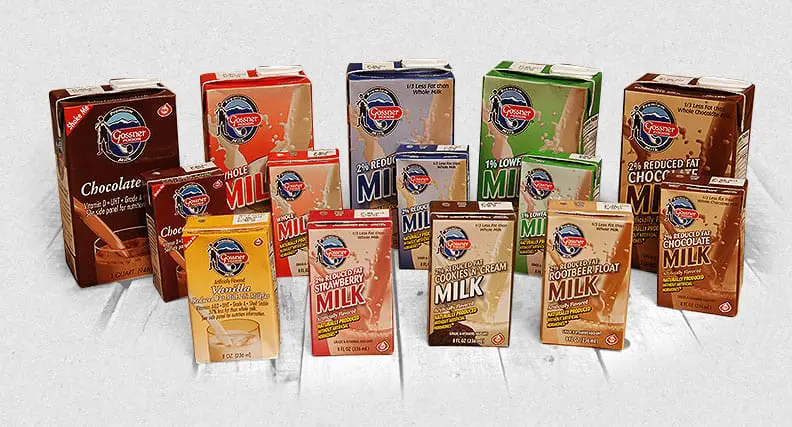
Consider Gossners U.H.T. Milk as an alternative to powdered milk for shorter-term food storage. This milk is awesome! It tastes like normal pasteurized milk but has a “best by date” of 6 to 9 months. Learn more about how great Gossner Milk is in our 3 Month Food Supply article.
Emergency Food Storage
In addition to long-term food storage include a designated Emergency 72-hour Food Kit. This food only needs water to cook. It can be bought in prepackaged servings or bulk. It is perfect for storms, power outages, natural disasters, and much more. Having this emergency 72-hour food supply when stores are not accessible will be life-saving. Be sure to put one of these emergency buckets at your home. Store in RV or bug-out vehicle for on the road meals. For ease and worry-free try Augason Farm’s 72 Hour Emergency Kit, Food Supply. (Check the price on Amazon). As far as freeze-dried meals go we enjoy Augason Farm’s food and highly recommend this 72-hour emergency food kit.
To learn more about 72-hour kits check out our article 72 Hour Kit Guide & Checklist For The Whole Family With PDF Download.
Freeze drying foods is a great way to preserve fruits and vegetables from your garden, build up your own personal emergency food supply, and for camping or backpacking meals. To learn if buying your own freeze dryer is right for you check out my article Buying a Home Freeze Dryer, What You Need to Know First!

Long term Food Storage Tips
- Food and water should be rotated every 6-12 months and use-by dates should be followed to ensure that they are safe to consume.
- Store canned goods in a dry, cool place, about 40-60°F to prevent spoiling (Centers for Disease Control and Prevention).
- Keep food protected from insects and rodents by storing in airtight containers (Centers for Disease Control and Prevention).
- Do not consume canned goods that have become swollen, dented, or corroded (American Red Cross).
- In case of a power outage, eat foods in the refrigerator first, then from the freezer, then from storage. In a well-insulated freezer, foods are usually good for 2 days if there are still ice crystals in the center of the food. Keep the fridge and freezer doors closed as much as possible (FEMA).
- Consider investing in a generator that can power your freezer and refrigerator to keep those foods from going bad.
- Make sure the fridge stays under 40° F. If the fridge is unopened, food will stay cool for about 4 hours (Seltzer).
- Food storage how-to guides (National Center for Home Food Preservation).
- Longer-Term Food Storage Tips form The Church of Jesus Christ of Latter-Day Saints
Long-Lasting Foods to Store that you can calculate using our Food Storage Calculator
Conclusion
Our goal with this food storage calculator was to make it complete with a variety of foods and easy to use. The calculator does all the hard work for you which will ease your planning.
We realize that starting food storage can be challenging and it’s hard to know where to start so we sincerely hope that this emergency essentials food storage calculator will be a valuable preparation tool and give you the confidence to start building food storage for your family. You never know if and when tragedy will strike so being prepared to provide food for your family is imperative. Good luck!

